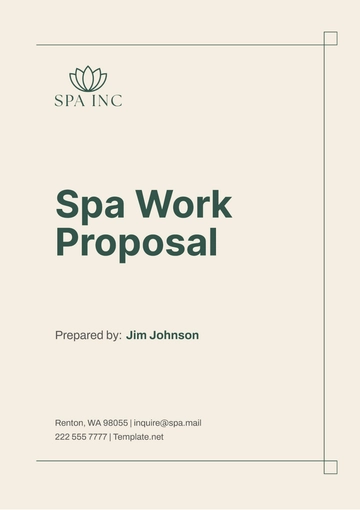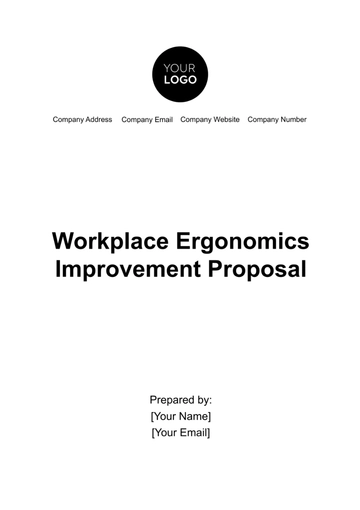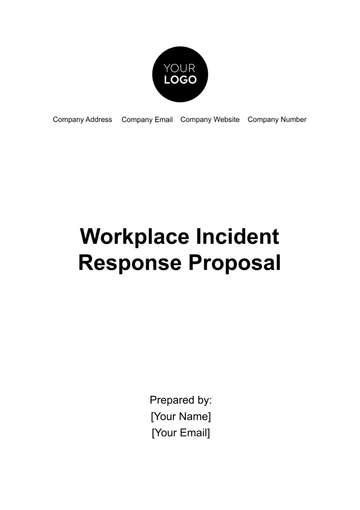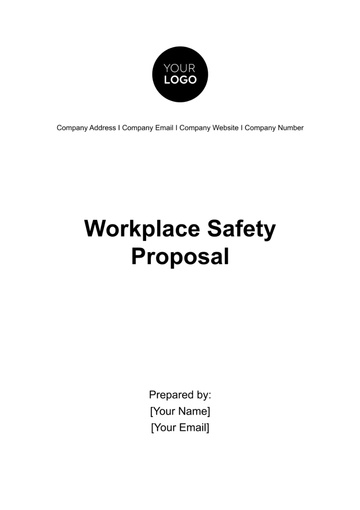Free Workplace Safety Proposal
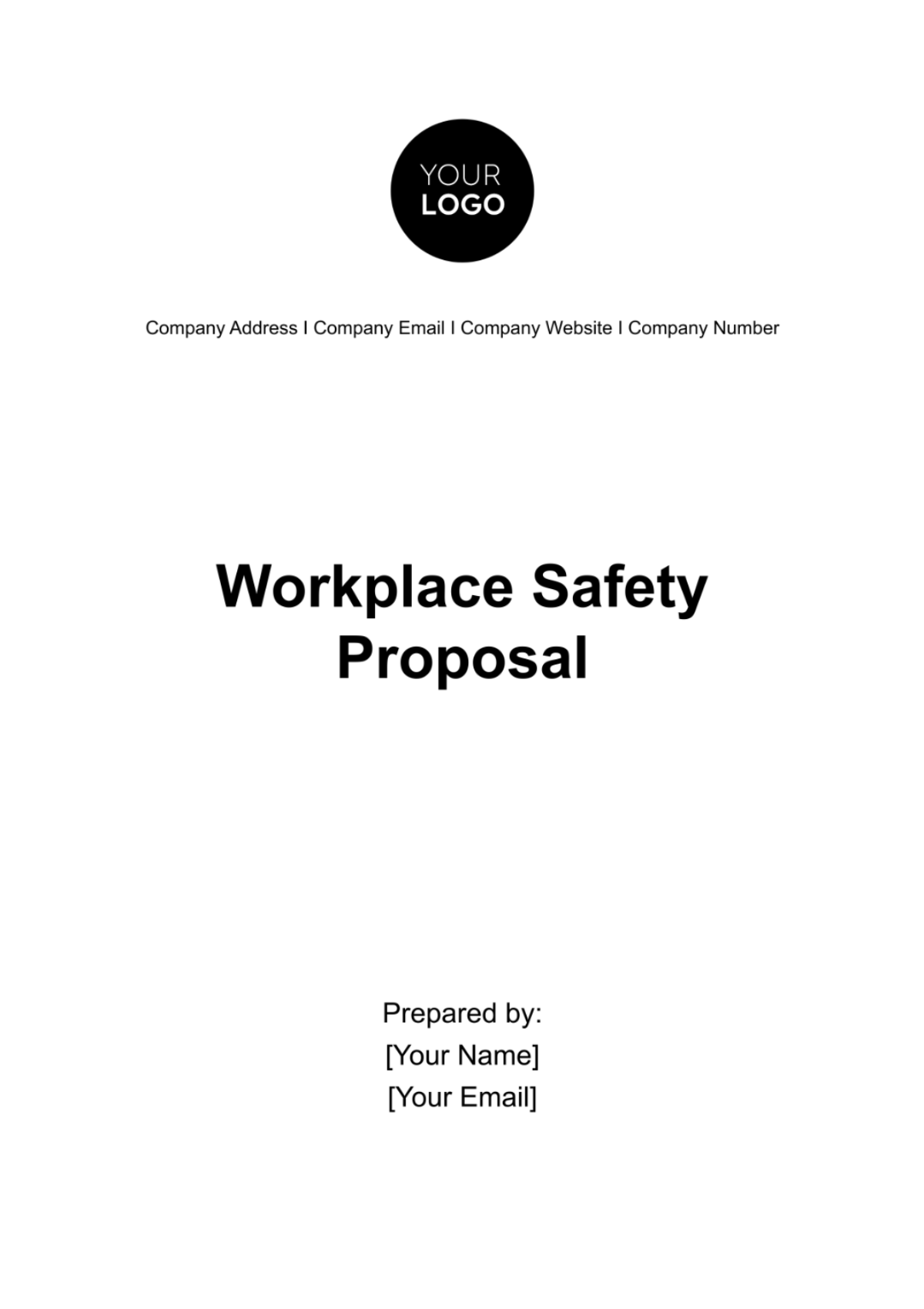
[Month Day, Year]
[Recipient's Name]
[Recipient's Title]
[Recipient's Company Name]
[Recipient's Company Address]
Dear [Recipient's Name],
I am writing to present a comprehensive Workplace Safety Proposal for [Recipient's Company Name]. At [Your Company Name], we understand the importance of creating a safe and secure work environment, and we are dedicated to assisting your organization in achieving and maintaining the highest standards of safety.
1. Executive Summary
Workplace safety is paramount for both the well-being of employees and the financial stability of any organization. Our Workplace Safety Proposal is designed to offer a thorough examination of the financial dimensions linked to our Health and Safety Policy at [Your Company Name].
In today's dynamic business landscape, ensuring a safe working environment transcends mere compliance—it is an investment that pays dividends. This proposal delves into the financial implications of workplace incidents, outlining the costs of medical expenses, workers' compensation, property damage, legal fees, and lost productivity incurred in the past year.
Furthermore, we elaborate on the costs associated with ensuring compliance, including employee training, safety equipment, safety audits, and safety software. Equally important, we evaluate the return on investment (ROI) in safety investments by considering reduced incidents, increased productivity, insurance premium savings, and enhanced reputation.
Moreover, we spotlight the tangible cost savings stemming from our Health and Safety Policy, including reductions in incidents, insurance premiums, workers' compensation, and legal fees. The final section aggregates all costs and savings to present a clear picture of your workplace safety expenditure. By the end of this proposal, we aim to demonstrate that investing in workplace safety not only safeguards your most valuable asset, your employees, but also contributes to long-term financial prosperity.
2. Introduction
Workplace incidents can have far-reaching financial implications for any organization. In the past year, we have meticulously analyzed the direct and indirect costs associated with such incidents, as summarized in the table below:
Category | Cost (in $000.00) |
Medical Expenses | [$000.00] |
Workers' Compensation | [$000.00] |
Property Damage | [$000.00] |
Legal Fees | [$000.00] |
Lost Productivity | [$000.00] |
Total Incident Costs | [$000.00] |
These costs underscore the significant financial burden that workplace incidents can impose. Beyond the immediate expenses, the impact extends to reduced productivity and potential legal repercussions. It is imperative that we proactively address safety concerns to mitigate these costs and, more importantly, safeguard the well-being of our employees. This Workplace Safety Proposal is designed to provide a comprehensive solution to enhance workplace safety, ultimately benefiting both our workforce and our financial stability.
3. Cost of Compliance
In our commitment to maintaining a secure workplace environment at [Your Company Name], ensuring compliance with safety regulations is a fundamental obligation. Compliance is not merely a box to check; it is a strategic investment in the well-being of our employees and the sustainable operation of our organization. This section provides a meticulous breakdown of our compliance costs, demonstrating our dedication to adhering to safety standards.
The table below outlines the specific costs associated with maintaining compliance with safety regulations. These costs encompass various aspects, from employee training to the acquisition of essential safety equipment, conducting safety audits, and implementing safety software:
Compliance Aspect | Cost (in $000.00) |
Employee Training | [$100.00] |
Safety Equipment | [$000.00] |
Safety Audits | [$000.00] |
Safety Software | [$000.00] |
Total Compliance Costs | [$000.00] |
These figures reflect our unwavering commitment to investing in employee education, acquiring essential safety gear, and conducting thorough safety audits and software implementation. This commitment is not only a demonstration of our dedication to safety but also a strategic decision to uphold our responsibilities and ensure the well-being of our workforce.
4. ROI on Safety Investments
Measuring the return on investment (ROI) of safety investments is pivotal for organizations committed to fostering a safe workplace. At [Your Company Name], we recognize that safety isn't just an expense; it's an investment with tangible returns. In this section, we delve into the benefits derived from our safety initiatives and calculate the ROI to provide a comprehensive understanding of the value of our safety investments.
To evaluate the ROI on safety investments, we must consider the diverse benefits that stem from our commitment to safety. The table below provides a breakdown of these benefits:
Benefit | Amount |
Reduced Incidents | 15 incidents prevented |
Improved Productivity | 10% increase |
Insurance Premium Savings | [$00,000] saved |
Reputation Enhancement | Positive impact on client satisfaction |
Total Benefits | [$000,000] |
These benefits underscore the concrete returns that result from our safety initiatives. By preventing incidents, enhancing productivity, reducing insurance costs, and bolstering our reputation, we not only protect our employees but also contribute to the overall success and sustainability of our organization. This ROI analysis demonstrates that safety investments are not just a cost but a strategic decision that reaps both financial and non-financial rewards.
5. Cost Savings from Health and Safety Policy
The implementation of our Health and Safety Policy has yielded substantial cost savings for [Your Company Name]. In this section, we provide a concise overview of the specific areas where our policy has resulted in financial benefits.
The table below outlines the key areas where our Health and Safety Policy has generated cost savings, along with sample details:
Cost Savings | Amount saved |
Reduced Incidents | [$00,000] |
Insurance Premium Reduction | [$00,000] |
Workers' Compensation Savings | [$00,000] |
Legal Fees Avoided | [$00,000] |
Total Cost Savings | [$000,000] |
These details demonstrate the tangible financial advantages stemming from our commitment to health and safety. By reducing incidents, securing insurance premium reductions, curbing workers' compensation expenses, and avoiding legal fees, we not only prioritize the well-being of our workforce but also fortify the financial stability of our organization. This cost savings analysis underscores the value of our Health and Safety Policy as a strategic investment that safeguards our employees and contributes to our long-term financial resilience.
6. Total Workplace Safety Expenditure
In evaluating the comprehensive financial impact of our workplace safety efforts, we need to assess both the costs incurred and the savings generated. This section provides a consolidated view of our total workplace safety expenditure, taking into account all relevant financial aspects.
The table below summarizes the key components of our total workplace safety expenditure, with sample details:
Expenditure Item | Amount (in $000.00) |
Total Cost of Workplace Incidents | [$2,300] |
Total Compliance Costs | [$000.00] |
Net Benefits from Safety Investments | [$000.00] |
Total Cost Savings | [$000.00] |
Net Workplace Safety Expenditure | [$000.00] |
The figures provide an overview of our financial commitment to workplace safety. While incident costs and compliance expenses are notable, they are offset by the benefits derived from our safety investments and the cost savings realized through our Health and Safety Policy. The net workplace safety expenditure reflects our dedication to prioritizing safety while maintaining financial prudence. This analysis reaffirms that safety is not just a cost but a strategic investment that contributes to both the well-being of our employees and the financial stability of our organization.
In conclusion, this Workplace Safety Proposal outlines a comprehensive plan to enhance safety within your organization. Our commitment to safety not only reduces risks but also ensures regulatory compliance, improves employee well-being, and boosts overall productivity. We look forward to partnering with [Recipient's Company Name] to create a safer and more secure workplace environment.
Please feel free to reach out to me at [Your Email] or [Your Company Number] to discuss this proposal further or address any questions you may have.
Sincerely,
[Your Name]
[Your Position]
- 100% Customizable, free editor
- Access 1 Million+ Templates, photo’s & graphics
- Download or share as a template
- Click and replace photos, graphics, text, backgrounds
- Resize, crop, AI write & more
- Access advanced editor
Introducing the Workplace Safety Proposal Template from Template.net. Crafted for seamless customization, this editable proposal is your key to a safer work environment. Utilize our Ai Editor Tool to tailor every detail to your specific needs. Safeguard your workplace with ease and precision using Template.net's innovative solutions.
You may also like
- Business Proposal
- Research Proposal
- Proposal Request
- Project Proposal
- Grant Proposal
- Photography Proposal
- Job Proposal
- Budget Proposal
- Marketing Proposal
- Branding Proposal
- Advertising Proposal
- Sales Proposal
- Startup Proposal
- Event Proposal
- Creative Proposal
- Restaurant Proposal
- Blank Proposal
- One Page Proposal
- Proposal Report
- IT Proposal
- Non Profit Proposal
- Training Proposal
- Construction Proposal
- School Proposal
- Cleaning Proposal
- Contract Proposal
- HR Proposal
- Travel Agency Proposal
- Small Business Proposal
- Investment Proposal
- Bid Proposal
- Retail Business Proposal
- Sponsorship Proposal
- Academic Proposal
- Partnership Proposal
- Work Proposal
- Agency Proposal
- University Proposal
- Accounting Proposal
- Real Estate Proposal
- Hotel Proposal
- Product Proposal
- Advertising Agency Proposal
- Development Proposal
- Loan Proposal
- Website Proposal
- Nursing Home Proposal
- Financial Proposal
- Salon Proposal
- Freelancer Proposal
- Funding Proposal
- Work from Home Proposal
- Company Proposal
- Consulting Proposal
- Educational Proposal
- Construction Bid Proposal
- Interior Design Proposal
- New Product Proposal
- Sports Proposal
- Corporate Proposal
- Food Proposal
- Property Proposal
- Maintenance Proposal
- Purchase Proposal
- Rental Proposal
- Recruitment Proposal
- Social Media Proposal
- Travel Proposal
- Trip Proposal
- Software Proposal
- Conference Proposal
- Graphic Design Proposal
- Law Firm Proposal
- Medical Proposal
- Music Proposal
- Pricing Proposal
- SEO Proposal
- Strategy Proposal
- Technical Proposal
- Coaching Proposal
- Ecommerce Proposal
- Fundraising Proposal
- Landscaping Proposal
- Charity Proposal
- Contractor Proposal
- Exhibition Proposal
- Art Proposal
- Mobile Proposal
- Equipment Proposal
- Student Proposal
- Engineering Proposal
- Business Proposal



